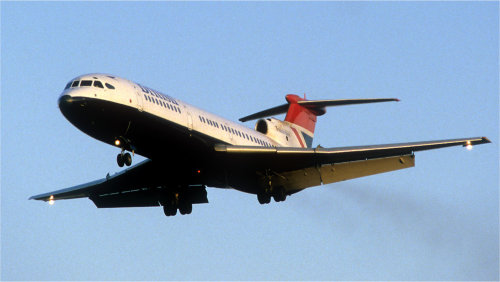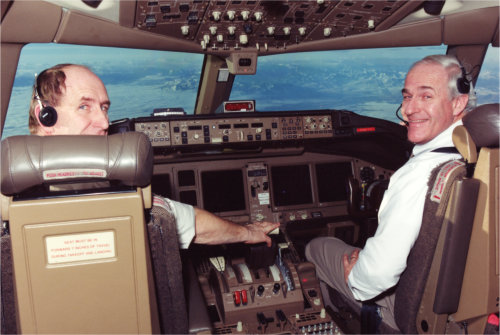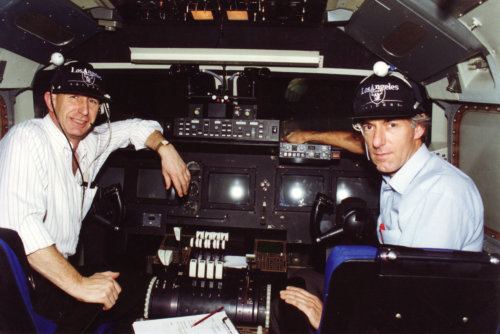Initial training
I qualified as a commercial pilot at the College of Air Training, a sponsored school established by the UK's then state-owned airlines British Overseas Airways Corporation (BOAC) and British European Airways (BEA).
 I joined BEA in 1965 at the age of 20 as a Second Officer (co-pilot) on the DH121 "Trident" fleet, just as it was entering service. This aircraft was the leading type for development of All-Weather Operations (AWOP) into Cat 2 and 3, including the first automatic landings with commercial passengers. As a co-pilot on this fleet I was exposed to much of the research information and flight and simulator experiments needed for the safe introduction of low-visibility commercial flights.
I joined BEA in 1965 at the age of 20 as a Second Officer (co-pilot) on the DH121 "Trident" fleet, just as it was entering service. This aircraft was the leading type for development of All-Weather Operations (AWOP) into Cat 2 and 3, including the first automatic landings with commercial passengers. As a co-pilot on this fleet I was exposed to much of the research information and flight and simulator experiments needed for the safe introduction of low-visibility commercial flights.
I was promoted to Captain on the Vickers "Merchantman" (Vanguard freighter) in 1974 and returned to the Trident as a Captain in 1976. In 1984 I qualified on the Boeing 757, and converted to the A320 on its introduction in 1979 as one of the initial "BA-origin" pilots on the type, the others having been with British Caledonian who had placed the order prior to being acquired by BAW.
Pilot representative.
I became involved in the British Airline Pilots Association (BALPA) technical and safety activities in 1969, later becoming Vice-chairman of BALPA's Technical Committee. I was a BALPA representative or nominee to the International Federation of Airline Pilots Associations (IFALPA) from 1970 until my retirement from line flying in 2000.
International organisations
In 1970 I became involved in the work of the International Civil Aviation Organisation's (ICAO) Airworthiness Committee as an IFALPA representative, and in 1973 was nominated by IFALPA as its member of the newly formed ICAO Operations Panel (OPSP). OPSP comprised senior regulators and operations experts from the USA, UK, Netherlands, USSR and several other nations, plus IFALPA and IATA, and had the primary initial task of drawing up the first ICAO Manual of All-Weather Operations, to provide guidance to States (many of which had no regulations of any kind) on rules and procedures for operations in poor weather.
This Manual was published in 1981 and is now in its 3rd edition (2013), and forms the basis of EUR Doc 013, European Guidance Material on Aerodrome Operations Under Limited Visibility Conditions. I was also IFALPA's alternate member of the ICAO Extended Range Twin-engined Operations (ETOPs) Group. My contribution to these ICAO activities efforts was recognised by an IFALPA award in 1981.
 As an IFALPA office holder I chaired the Aircraft Design and Operations (ADO) Committee before serving two terms on the IFALPA "Board", initially as Principal Vice President (Technical) and then as Principal Vice President (Administration and Finance), before resuming as ADO Chairman for a further 8 years. In 2002 I was presented with IFALPA's highest honour, the CN Sayen Award, for service to the international airline pilot profession.
As an IFALPA office holder I chaired the Aircraft Design and Operations (ADO) Committee before serving two terms on the IFALPA "Board", initially as Principal Vice President (Technical) and then as Principal Vice President (Administration and Finance), before resuming as ADO Chairman for a further 8 years. In 2002 I was presented with IFALPA's highest honour, the CN Sayen Award, for service to the international airline pilot profession.
During that period for about 18 years I was also IFALPA's representative on the Society of Aerospace Engineers Committee S-7. SAE S-7 is composed of senior manufacturer and aviation authority test pilots and airline chief technical pilots, together with engineering and human factors experts from research and manufacturing organisations, and creates standards for transport aircraft flight deck design and handling qualities. I was chairman of this committee from 1994 until 1998.
Work with manufacturers and others
While an IFALPA representative, I was a full-time line pilot for British Airways, and was part of the BAW/BALPA project team when BAW was launch customer for the Boeing 757, which I flew from soon after its introduction. In 1989 I converted onto the Airbus A320 upon its introduction to BA, and was the author of technical papers on aspects of flight deck automation and design, particularly differences between Airbus and Boeing philosophy.I believe for a while I was the only line pilot anywhere qualified on both major manufacturers' "glass cockpit" types.

In these various representative positions I was a frequent participant at industry conferences on low visibility and wind-shear related operations and was a subject pilot in many experimental programmes at such facilities as RAE Bedford, NASA Ames, FAA Oklahoma City, Flight Dynamics, and French and Netherlands aviation institutes, where research into low visibility operations included development of Head-Up Displays and Enhanced Vision systems.
Because of this unusual background in 1989 I was asked to join British Airways' Flight Operations technical management team, as the project pilot for the developement of the Canadair Challenger business jet to become the Canadair Regional Jet (CRJ), for which BA at the time was the lead potential launch customer. In that role I was particularly concerned with exploring how the CRJ could obtain the Category 2 and 3A landing capability needed for the BA network. This involved examining the ability of pilots to integrate enhanced autopilots and flight directors into safe "fail-passive" and manual landing systems with or without HUDs. Although at the end of this 2 year development programme BA did not confirm its order for this aircraft, it has been a success for many other operators.
In 1992 I converted onto the B747-400 and continued for the next 8 years as both an IFALPA technical representative and as British Airways technical project pilot for "developing technologies", which covered evaluating all proposed new equipment for airliner flight decks (e.g. airborne data management systems, communications systems, instrumentation changes etc). I was also a consultant to Rockwell Collins in assembling their bid for the Electronic Library System for the Boeing 777. A further BA task was to draft a unified operational philosophy document for all of BA's flight operations which brought together and harmonised the substantial remaining differences (especially in approach procedures) from BA's legacy operations as BOAC and BEA.
PicMA Experience
I retired from BA on reaching the then compulsory contract retirement age of 55 in 2000, as the most senior Captain in the airline, after having flown over 16,000 hours and 8,300 sectors. Of this 10,000 hours and 5000 sectors were as Captain.
As will be evident from this CV, the vast majority of my line flying experience was using PicMA and "delegated flying" as the basic procedure, so I have experienced its use many thousands of times as both pilot and co-pilot. However, that does not mean that I have never flown an approach and landed off it! I have of course used "traditional" procedures many times in experimental flying and in training, and in line operations in good weather.
I am a strong believer in allowing Captains the flexibility to use their discretion in judging the actual conditions encountered on a day to day basis. This philosophy recognises that there are major benefits in using the existence of alleviating factors (such as obvious actual good weather conditions) to permit pilots to practice, for example, manual flying of the descent and approach through to landing, in order to maintain proficiency at ALL aspects of aircraft handling. This is completely compatible with making PicMA the default procedure that will be used for normal operation.
After retirement from BA, I continued as a consultant to Rockwell Collins and other organisations, but then set up a small business in a non-aviation related activity. I received the IFALPA highest recognition, the C N Sayen Award, at the IFALPA Annual Conference in April 2002, and have maintained a watching interest in airline operations since then.
This website was started in 2014 following a request for information about a paper on PicMA related issues, circulated in the late 1990s and the subject of well-received presentations to boht Boeing and.Airbus senior flight operations and engineering groups.
Flying experience
| 1963-65 | Initial Training BEA/BOAC College of Air Training > BEA > British Airways | |
| 1965-74 | F/O: HS Trident 4900 hrs 3270 sectors | |
| 1975-77 | Captain: Vickers Merchantman 470 hrs 250 sectors | |
| 1977-84 | Captain HS Trident 2900 hrs 2200 sectors | |
| 1984-89 | Captain Boeing 757 2430 hrs 1400 sectors | |
| 1989-92 | Captain Airbus A320 850 hrs 600 sectors | |
| 1992-2000 | Captain Boeing 747-400 4550 hrs 500 sectors |